Istanbul's Improvements
The cores inside “Istanbul” are not different from those found in Shanghai. Istanbul introduces only a few improvements: HT assist, slightly higher HT speeds, APML and x8 ECC.
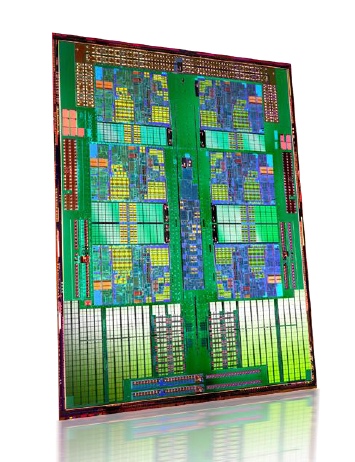
X8 ECC: Each DRAM chip on a DIMM provides either 4 bits or 8 bits of a 64-bit data word. Chips that provide 4 bits are called x4 (by 4), and chips that provide 8 bits are called x8 (by 8). It takes eight x8 chips or sixteen x4 chips to make a 64-bit word, so at least eight chips are located on one or both sides of a DIMM. Istanbul’s memory controller now supports error correction for both x4 and x8 DIMMs.
APML Remote Power Management Interface: APML provides an interface that allows you to monitor and control platform power consumption via P-state limits. You need to have a CPU and BMC (management processor) that support APML on the server and you need to have some type of software (OS or management software) that supports APML and allows you to monitor power and make changes to power management parameters. Both hardware and software are in development, so this won’t be available on the servers that will be launched this month. APML is interesting as it would allow you to cap power without going into the BIOS. AMD’s PowerCap Manager allows you to limit power to a certain amount by making sure the CPU’s clock never goes beyond a certain limit, effectively underclocking the CPU. This is very useful in a datacenter that is cooling or power limited. Of course, BIOS options are not that handy in a datacenter with hundreds of servers. That is where APML could make the difference.
Higher HT Speeds: The later versions of the “Shanghai” Opteron versions support HyperTransport 3.0 or HT3. HT3 allows much higher clockspeeds than the HyperTransport links that all the older Opterons have been using so far (1GHz). The clockspeed was boosted to 2.2 GHz DDR, good for 8.8 GB/s in each direction. Istanbul pushes the clock of the HyperTransport up to 2.4GHz DDR, good for 9.6 GB/s in each direction. Or as fast as the QPI links which can be found on the slower “Nehalem” Xeons. Since the new Fiorano platform is not ready, we still have to test with an older NVIDIA MCP55 platform. But that does not matter; the CPU interconnect speed is handled by the CPUs, not the board or chipset. You can clearly see in the BIOS screenshot below:
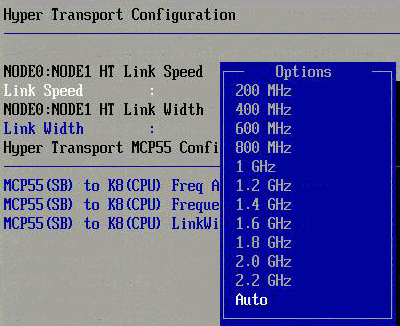
The last improvement is HT Assist. We will discuss this feature in more detail.
HT Assist: Only for the Quad-Socket
HT assist is a probe or snoop filter AMD implemented. First, let us look at a quad Shanghai system. CPU 3 needs a cacheline which CPU 1 has access to. The most recent data is however in CPU’s 2 L2-cache.
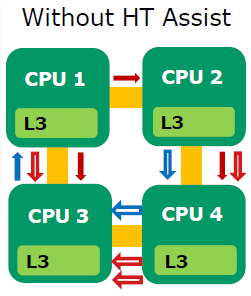
Start at CPU 3 and follow the sequence of operations:
1. CPU 3 requests information from CPU 1 (blue “data request” arrow in diagram)
2. CPU 1 broadcasts to see if another CPU has more recent data (three red “probe request” arrows in diagram)
3. CPU 3 sits idle while these probes are resolved (four red & white “probe response” arrows in diagram)
4. The requested data is sent from CPU 2 to CPU 3 (two blue and white “data response” arrows in diagram)
There are two serious problems with this broadcasting approach. Firstly, it wastes a lot of bandwidth as 10 transactions are needed to perform a relatively simple action. Secondly, those 10 transactions are adding a lot of latency to the instruction on CPU 3 that needs the piece of data (which was requested by CPU 3 to CPU 1).
The solution to is a directory-based system, that AMD calls HT Assist. HT assist reserves 1MB portion of each CPU’s L3 cache to act as a directory. This directory tracks where that CPU’s cache lines are used elsewhere in the system. In other words the L3-caches are only 5 MB large, but a lot of probe or snoop traffic is eliminated. To understand this look at the picture below:
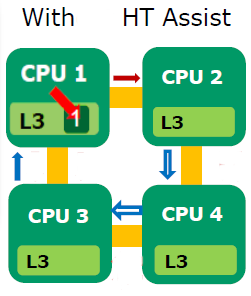
Let us see what happens. Start again with CPU 3:
1. CPU 3 requests information from CPU 1 (blue line)
2. CPU 1 checks its L3 directory cache to locate the requested data (Fat red line)
3. The read from CPU 1’s L3 directory cache indicates that CPU 2 has the most recent copy and directly probes CPU 2 (Dark red line)
4. The requested data is sent from CPU 2 to CPU 3 (blue and white lines)
Instead of 10 transactions, we have only 4 this time. A considerable reduction in latency and wasted bandwidth is the result. Probe “broadcasting” can be eliminated in 8 of 11 typical CPU-to-CPU transactions. Stream measurements show that 4-Way memory bandwidth improves 60%: 41.5GB/s with HT Assist versus 25.5GB/s without HT Assist.
But it must be clear that HT assist is only useful in a quad-socket system and of the utmost importance in octal CPU systems. In a dual system, broadcast is the same as a unicast as there is only one other CPU. HT assist also lowers the hitrate of L2-caches (5 MB instead of 6) so it should be disabled on 2P systems. If you look in the BIOS...
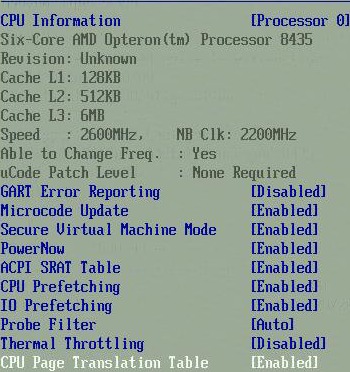
...you get 3 options next to probe filter: “auto”, “disabled” and “MP”. In automatic mode the probe filter or HT Assist will be turned off for 2P systems. You can force “HT assist” by setting “MP”, indicating there are more than 2 processors.










40 Comments
View All Comments
befair - Wednesday, June 3, 2009 - link
yeah, yeah, its always "more details review coming soon"smith1795 - Thursday, June 4, 2009 - link
http://cheap-conveyancing-online.blogspot.com
http://gadgets-gizmo.vox.com
http://solicitorwill.blogg.de/">http://solicitorwill.blogg.de/
http://www.blogigo.co.uk/conveyancing_solicitors">http://www.blogigo.co.uk/conveyancing_solicitors
genkk - Tuesday, June 2, 2009 - link
ohhh I see, johan is only doing what his boss (anand) has told him so...aguilpa1 - Monday, June 1, 2009 - link
As an AMD fanboy I skipped to the one metric that AMD shows competitive performance and focused on that ignoring all other.classy - Monday, June 1, 2009 - link
That is laughable. Lets see I have only purchased all Intel servers in the last 7 years. But in the last 2 years anyone who does any system administration knows virtualization has just leaped to the forefront. Its that important. Even email is being virtualized. Databases are still physical and will probably be for some time to come. But make no mistake about it, how well it does at virtualizing is at the top of the list. Especially considering the recent recession. Virtualizing allows more to be done with less of everything. Next time maybe have some experience in something else besides reading the internet and maybe you might understand a thing or two.Natfly - Monday, June 1, 2009 - link
Virtualization isn't the be-all end-all of computing. It definitely can be a way to make more efficient use of your hardware, but the "virtualize everything" mentality isn't going to help you in the long run.solicitorsuk - Saturday, September 26, 2009 - link
This is the thing that i looking for from couple months ago.http://solicitorsuk.blogspot.com/">http://solicitorsuk.blogspot.com/
nycromes - Tuesday, June 2, 2009 - link
I don't think thats really what he/she was saying, they were saying that in terms of the IT world, Virtualization is now one of the (if not the) most important features. Right now, there are major pushes in the industry to make more efficient use of hardware, virtualization is one major part of doing that. I agree that a "virtualize everything" mentality is not good, but the OP makes a great point about the importance of virtualization in todays IT world.Jakey1999 - Thursday, May 6, 2010 - link
Dudes,What would you recommend for a SQL Server 2005 64bit database server? Hybrd, system OTLP and OLAP - 75% read. Thanks. Please respond to e-mail "jerry@tre.wa.gov". Thanks man.
AlexRot - Wednesday, October 7, 2020 - link
Компания Азия-Трейдинг оказывает весь комплекс вэд услуг по таможенному оформлению грузов экспортно-импортного направления. Мы контролируем каждый шаг для того, чтобы Ваши грузы оформлялись без задержек. Доскональное знание условий оформления и профессионализм сотрудников позволяет добиться значительного снижения издержек и максимальной скорости оформления грузов.